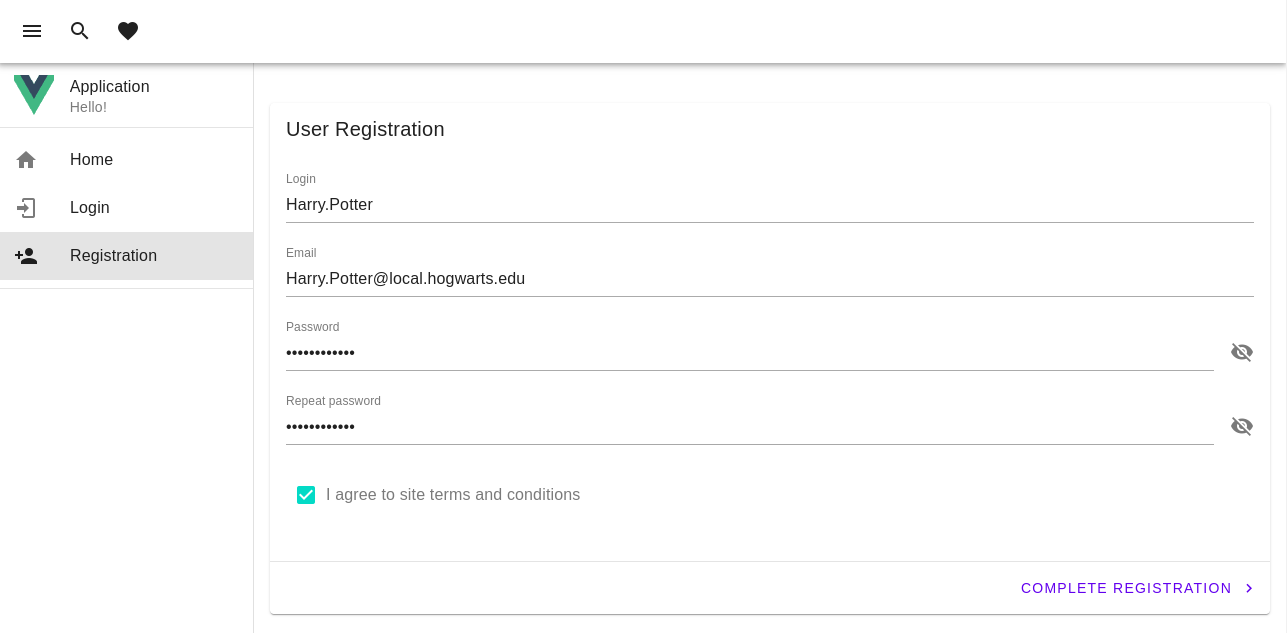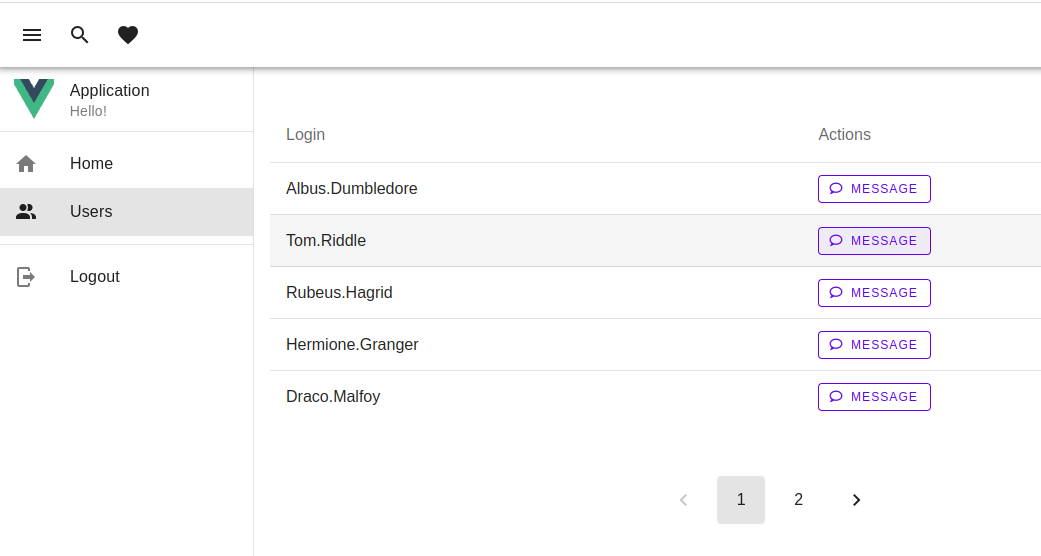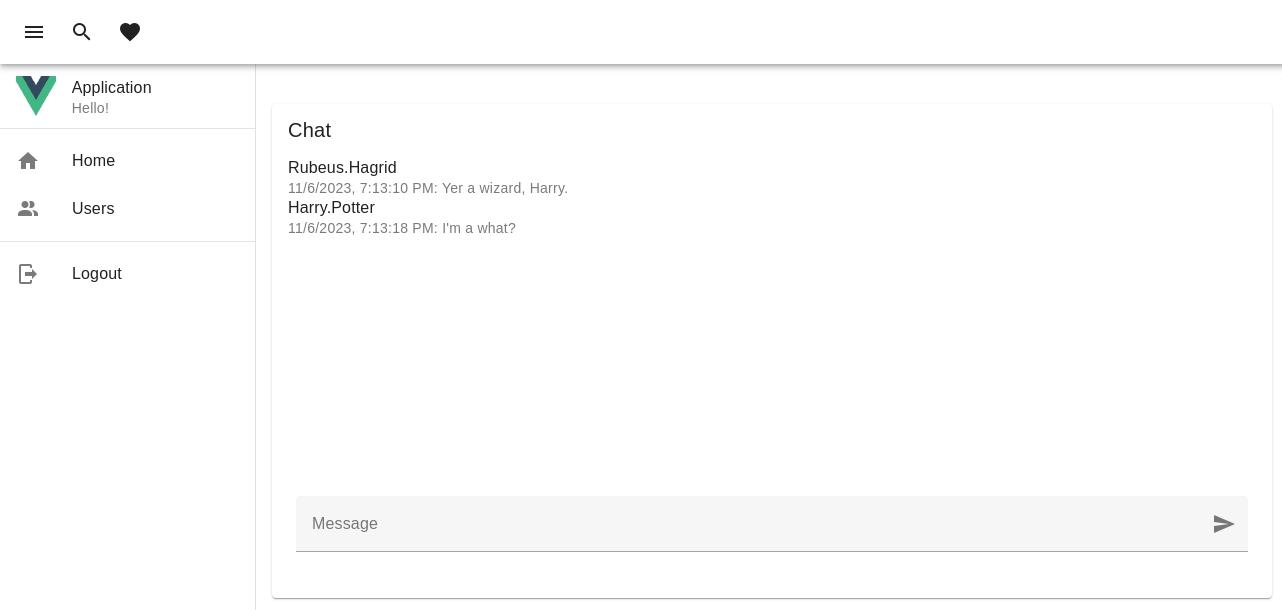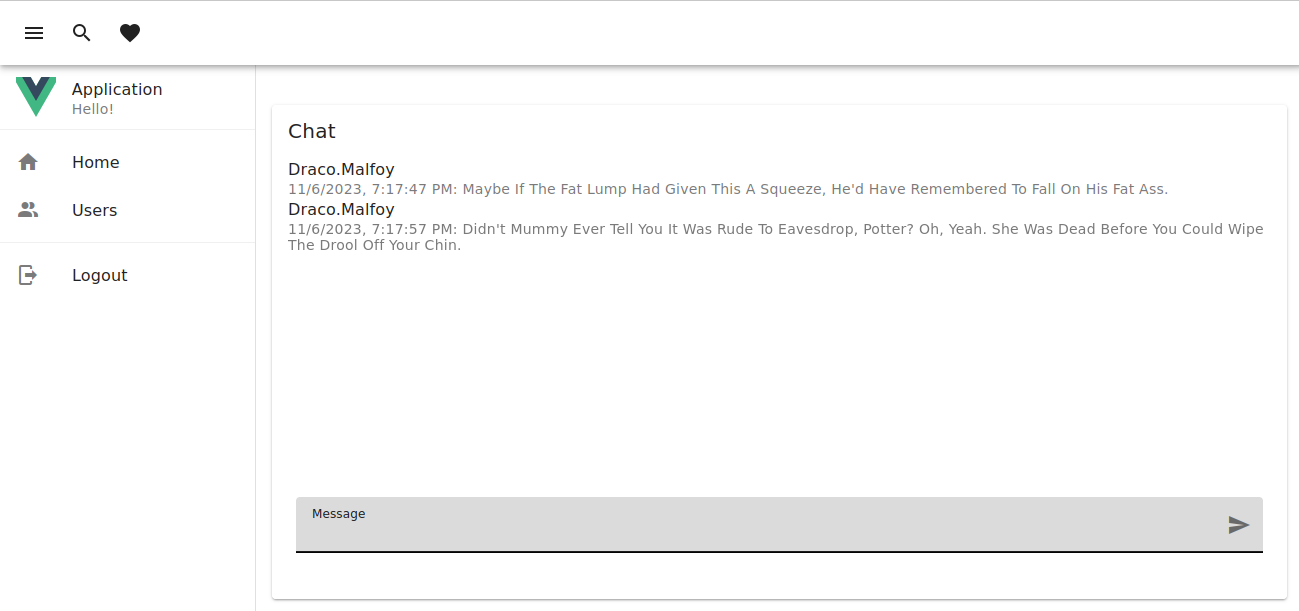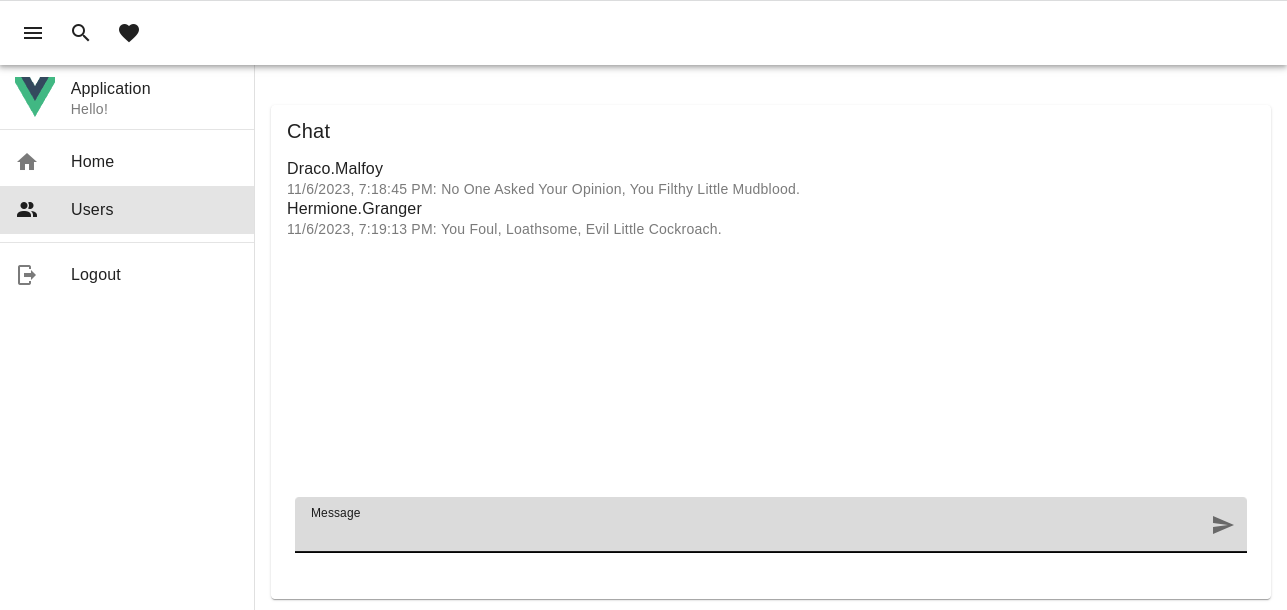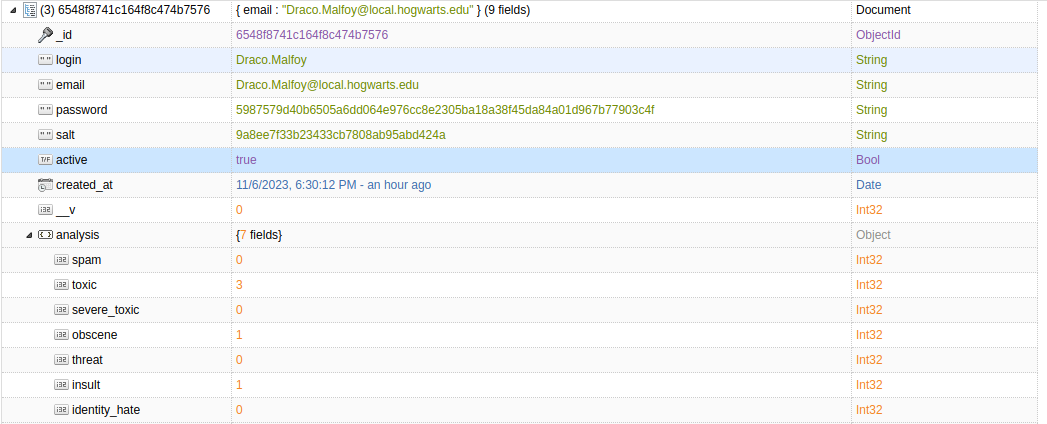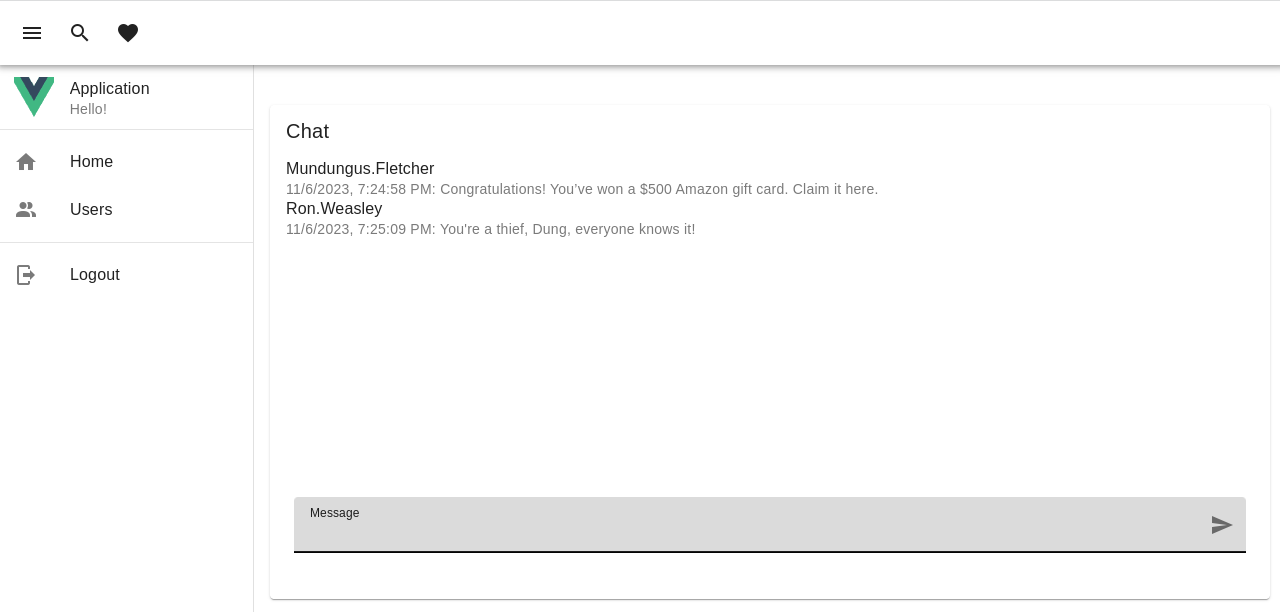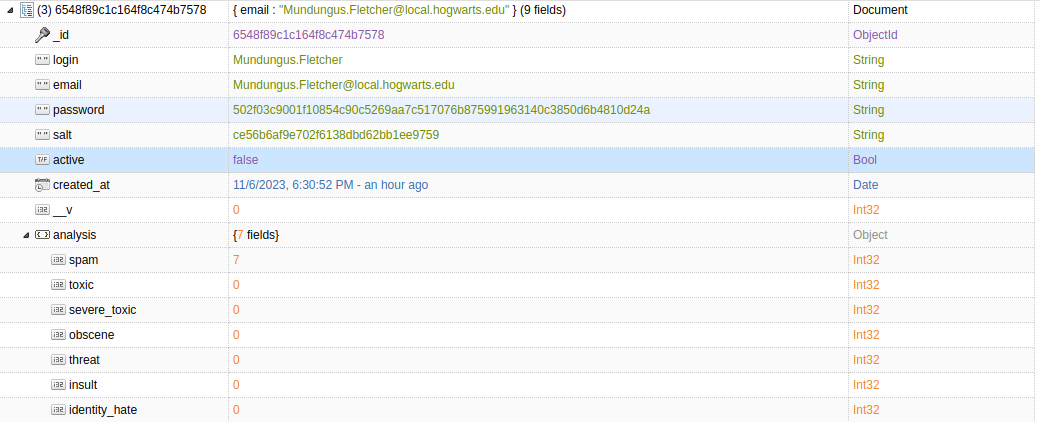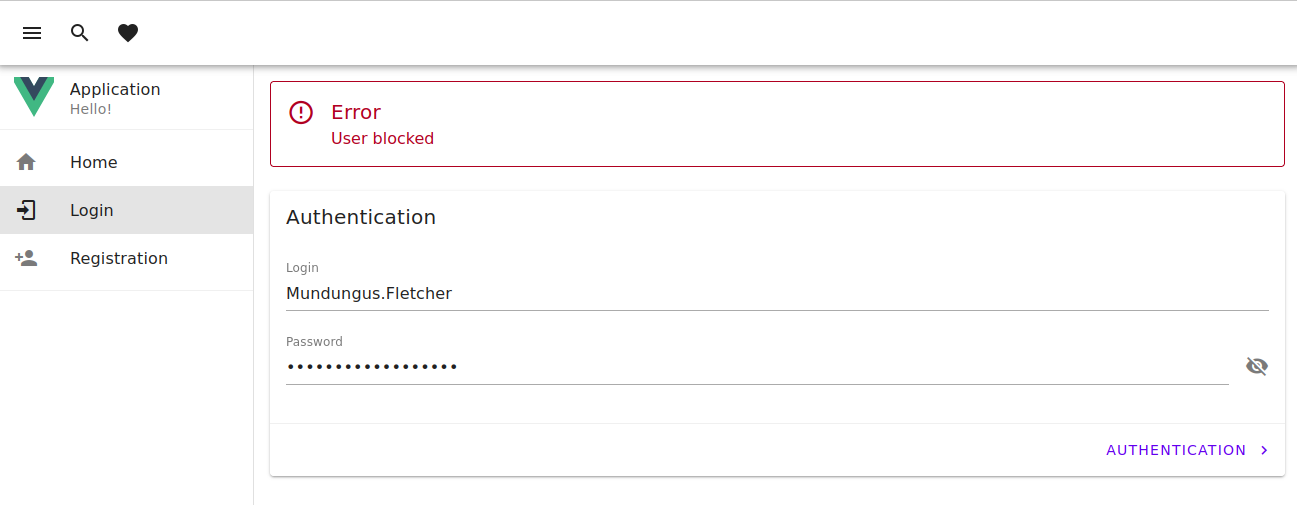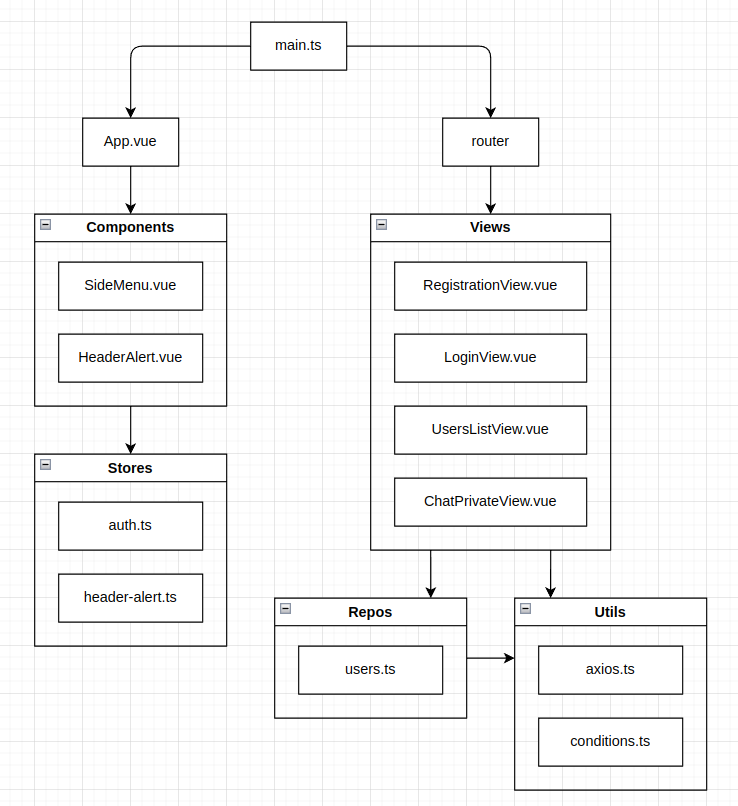Full code of example - link
- Provide registration
- Provide login
- Provide list of users
- Provide conversation between users
Additionally:
- Not allow blocked users to login again
Here I will show how to create a little front-end application, with all described functionality. I use the vue framework and vuetifyjs as a ui library. I use axios for http requests, with JWT token for user access and socket.io for messaging. I use pinia to have storage and share data between different views and components.
First file - main.ts initiation of service.
import { createApp } from "vue";
import { createPinia } from "pinia";
import App from "./App.vue";
import router from "./router";
import "@mdi/font/css/materialdesignicons.css";
import "vuetify/styles";
import { createVuetify } from "vuetify";
import * as components from "vuetify/components";
import * as directives from "vuetify/directives";
const vuetify = createVuetify({
components,
directives,
});
const app = createApp(App);
app.config.errorHandler = (error, vm, info) => {
console.log("error", error, "info", info);
};
app.use(createPinia());
app.use(router);
app.use(vuetify);
app.mount("#app");App.vue - this is the layout. Layout contains two components SideMenu.vue and HeaderAlert.vue.
<script lang="ts">
import SideMenu from "./components/SideMenu.vue";
import HeaderAlert from "./components/HeaderAlert.vue";
import { useHeaderAlertStore } from "./stores/header-alert";
export default {
data: () => ({
toggle: true,
}),
methods: {
toggleDrawer() {
this.toggle = !this.toggle;
},
},
components: { SideMenu, HeaderAlert },
errorCaptured(error: any) {
const headerAlertStore = useHeaderAlertStore();
headerAlertStore.setError(error);
if (error.response?.status === 401) {
this.$router.push({ name: "login" });
}
},
};
</script>
<template>
<v-app>
<!-- header -->
<v-app-bar>
<v-app-bar-nav-icon
variant="text"
@click.stop="toggleDrawer"
></v-app-bar-nav-icon>
<v-btn icon>
<v-icon>mdi-magnify</v-icon>
</v-btn>
<v-btn icon>
<v-icon>mdi-heart</v-icon>
</v-btn>
</v-app-bar>
<!-- side menu -->
<SideMenu v-model="toggle"></SideMenu>
<!-- content -->
<v-main>
<v-container>
<HeaderAlert></HeaderAlert>
<RouterView />
</v-container>
</v-main>
</v-app>
</template>HeaderAlert.vue - shows notifications on the top of the page.
<script lang="ts">
import { useHeaderAlertStore } from "../stores/header-alert";
export default {
data: function () {
const headerAlertStore = useHeaderAlertStore();
return {
headerAlertStore: headerAlertStore,
};
},
};
</script>
<template>
<v-alert
v-if="Boolean(headerAlertStore.success)"
icon="mdi-alert-circle-outline"
variant="outlined"
color="success"
title="Success"
>
{{ headerAlertStore.success?.message }}
</v-alert>
<v-alert
v-if="Boolean(headerAlertStore.error)"
icon="mdi-alert-circle-outline"
variant="outlined"
color="error"
title="Error"
>
{{ headerAlertStore.error?.message }}
</v-alert>
<br />
</template>SideMenu.vue - contains links from the left menu of the page, links should be different, depending on the user state - logged or not logged.
<script lang="ts">
import { useAuthStore } from "../stores/auth";
export default {
data: function () {
const authStore = useAuthStore();
return {
title: "Application",
authStore,
};
},
methods: {
logout: function () {
this.authStore.logout();
this.$router.push({ name: "login" });
},
},
};
</script>
<template>
<v-navigation-drawer>
<v-list>
<v-list-item>
<v-row no-gutters>
<v-col cols="3">
<v-avatar image="/src/assets/logo.svg" rounded="0"></v-avatar>
</v-col>
<v-col>
<v-list-item-title>{{ title }} </v-list-item-title>
<v-list-item-subtitle>Hello!</v-list-item-subtitle>
</v-col>
</v-row>
</v-list-item>
</v-list>
<v-divider></v-divider>
<v-list>
<v-list-item title="Home" value="Home" prepend-icon="mdi-home" to="/">
</v-list-item>
<v-list-item
v-if="!authStore?.auth"
title="Login"
value="Login"
prepend-icon="mdi-login"
to="/login"
>
</v-list-item>
<v-list-item
v-if="!authStore?.auth"
title="Registration"
value="Registration"
prepend-icon="mdi-account-plus"
to="/registration"
>
</v-list-item>
<v-list-item
v-if="authStore?.auth"
title="Users"
value="Users"
prepend-icon="mdi-account-multiple"
to="/users-list"
>
</v-list-item>
</v-list>
<v-divider></v-divider>
<v-list v-if="authStore?.auth">
<v-list-item
title="Logout"
value="Logout"
prepend-icon="mdi-logout"
@click="logout"
>
</v-list-item>
</v-list>
</v-navigation-drawer>
</template>User login happens in the LoginView.vue, but I need to change links in the side menu for logged users. To have actual user's state I will use stores/auth.ts
import { defineStore } from "pinia";
export const useAuthStore = defineStore("counter", {
state: () => {
const accessToken: string | null = localStorage.getItem("accessToken");
const refreshToken: string | null =
localStorage.getItem("refreshToken");
return {
accessToken,
refreshToken,
auth: Boolean(accessToken),
};
},
actions: {
refresh({ accessToken, refreshToken }: { accessToken: string, refreshToken: string }) {
localStorage.setItem("accessToken", accessToken);
localStorage.setItem("refreshToken", refreshToken);
this.accessToken = accessToken;
this.refreshToken = refreshToken;
},
login({ accessToken, refreshToken }: { accessToken: string, refreshToken: string }) {
localStorage.setItem("accessToken", accessToken);
localStorage.setItem("refreshToken", refreshToken);
this.accessToken = accessToken;
this.refreshToken = refreshToken;
this.auth = true;
},
logout() {
localStorage.removeItem("accessToken");
localStorage.removeItem("refreshToken");
this.accessToken = null;
this.refreshToken = null;
this.auth = false;
},
},
});Errors may happen in any view after a user's actions or http request, but I always want to show these at the top of the page. To have data for alerts in the header I will use stores/header-alert.ts.
import { defineStore } from "pinia";
export const useHeaderAlertStore = defineStore("headerAlert", {
state: () => {
return {
error: undefined,
success: undefined,
};
},
actions: {
clear(type: string, dt: number) {
setTimeout(() => {
if (this[type]?.dt === dt) {
this[type] = undefined;
}
}, 10000);
},
setError(error: any) {
this.success = undefined;
const dt = Date.now();
this.error = {
...error,
dt,
message: error.response?.data?.message || error.message,
};
this.clear("error", dt);
},
setSuccess(success: any) {
this.error = undefined;
const dt = Date.now();
this.success = {
dt,
message: success.response?.data?.message || success.message,
data: success.response?.data || success.data,
};
this.clear("success", dt);
},
},
});Router - router/index.ts contains the list of routes and views for them.
import { createRouter, createWebHistory } from "vue-router";
const router = createRouter({
history: createWebHistory(import.meta.env.BASE_URL),
routes: [
{
path: "/",
name: "home",
component: () => import("../views/HomeView.vue"),
},
{
path: "/login",
name: "login",
component: () => import("../views/LoginView.vue"),
},
{
path: "/registration",
name: "registration",
component: () => import("../views/RegistrationView.vue"),
},
{
path: "/users-list",
name: "users-list",
component: () => import("../views/UsersListView.vue"),
},
{
path: "/chat-private/:userId",
name: "chat-private",
component: () => import("../views/ChatPrivateView.vue"),
},
],
});
export default router;RegistrationView.vue - implements registration of users.
<script lang="ts">
import { registerUser } from "@/repos/users";
import { isEmailValid } from "@/utils/conditions";
import { useHeaderAlertStore } from "@/stores/header-alert";
const headerAlertStore = useHeaderAlertStore();
export default {
data: () => ({
valid: false,
showPwd: false,
showRPwd: false,
login: "",
loginRules: [(value: string) => !!value || "Login is required"],
email: "",
emailRules: [
(value: string) => !!value || "E-mail is required",
(value: string) => {
return isEmailValid(value) || "E-mail must be valid";
},
],
password: "",
passwordRules: [(value: string) => !!value || "Password is required"],
passwordRepeat: "",
terms: false,
termsRules: [(value: string) => !!value || "Accept of terms is required"],
}),
methods: {
async sendRegistration(event: any) {
event?.preventDefault();
try {
const { valid } = await this.validateField();
if (!valid) {
return;
}
const { login, email, password, passwordRepeat } = this;
await registerUser({
login,
email,
password,
passwordRepeat,
});
headerAlertStore.setSuccess({
message: "Registration completed! Let's try to login!",
});
setTimeout(() => {
this.$router.push({ name: "login" });
}, 1000);
} catch (error) {
headerAlertStore.setError(error);
}
},
passwordRepeatRules(value: string) {
return value === this.password || "Repeat password please!";
},
validateField() {
return this.$refs.form.validate();
},
},
watch: {
login: "validateField",
email: "validateField",
password: "validateField",
passwordRepeat: "validateField",
terms: "validateField",
},
};
</script>
<template>
<v-form ref="form" v-model="valid" lazy-validation @submit="sendRegistration">
<v-card class="mx-auto" title="User Registration">
<v-container>
<v-text-field
v-model="login"
:rules="loginRules"
color="primary"
label="Login"
variant="underlined"
required
></v-text-field>
<v-text-field
v-model="email"
:rules="emailRules"
color="primary"
label="Email"
variant="underlined"
required
></v-text-field>
<v-text-field
v-model="password"
:rules="passwordRules"
:append-icon="showPwd ? 'mdi-eye' : 'mdi-eye-off'"
:type="showPwd ? 'text' : 'password'"
color="primary"
label="Password"
placeholder="Enter your password"
variant="underlined"
required
@click:append="showPwd = !showPwd"
></v-text-field>
<v-text-field
v-model="passwordRepeat"
:rules="[passwordRepeatRules]"
:append-icon="showRPwd ? 'mdi-eye' : 'mdi-eye-off'"
:type="showRPwd ? 'text' : 'password'"
color="primary"
label="Repeat password"
placeholder="Repeat your password"
variant="underlined"
required
@click:append="showRPwd = !showRPwd"
></v-text-field>
<v-checkbox
v-model="terms"
:rules="termsRules"
color="secondary"
label="I agree to site terms and conditions"
></v-checkbox>
</v-container>
<v-divider></v-divider>
<v-card-actions>
<v-spacer></v-spacer>
<v-btn color="primary" type="submit">
Complete Registration
<v-icon icon="mdi-chevron-right" end></v-icon>
</v-btn>
</v-card-actions>
</v-card>
</v-form>
</template>LoginView.vue - implements login of users.
<script lang="ts">
import { loginUser } from "@/repos/users";
import { useHeaderAlertStore } from "@/stores/header-alert";
const headerAlertStore = useHeaderAlertStore();
export default {
data: () => ({
valid: false,
showPwd: false,
login: "",
loginRules: [(value: string) => !!value || "Login is required"],
password: "",
passwordRules: [(value: string) => !!value || "Password is required"],
}),
methods: {
async sendLogin(event: any) {
event.preventDefault();
const { valid } = await this.validateField();
if (!valid) {
return;
}
try {
const { login, password } = this;
await loginUser({
login,
password,
});
headerAlertStore.setSuccess({
message: "Login successful. Welcome!",
});
setTimeout(() => {
this.$router.push({ name: "users-list" });
}, 1000);
} catch (error) {
headerAlertStore.setError(error);
}
},
validateField() {
return this.$refs.form.validate();
},
},
watch: {
login: "validateField",
password: "validateField",
},
};
</script>
<template>
<v-form ref="form" v-model="valid" lazy-validation @submit="sendLogin">
<v-card class="mx-auto" title="Authentication">
<v-container>
<v-text-field
v-model="login"
:rules="loginRules"
color="primary"
label="Login"
variant="underlined"
required
></v-text-field>
<v-text-field
v-model="password"
:rules="passwordRules"
:append-icon="showPwd ? 'mdi-eye' : 'mdi-eye-off'"
:type="showPwd ? 'text' : 'password'"
color="primary"
label="Password"
placeholder="Enter your password"
variant="underlined"
required
@click:append="showPwd = !showPwd"
></v-text-field>
</v-container>
<v-divider></v-divider>
<v-card-actions>
<v-spacer></v-spacer>
<v-btn color="primary" type="submit">
Authentication
<v-icon icon="mdi-chevron-right" end></v-icon>
</v-btn>
</v-card-actions>
</v-card>
</v-form>
</template>UsersListView.vue - implements list of users. Here I make the a of users with pagination.
<script lang="ts">
import { getUsersList } from "@/repos/users";
import { useHeaderAlertStore } from "@/stores/header-alert";
const headerAlertStore = useHeaderAlertStore();
export default {
data: () => ({
users: [],
count: 0,
skip: 0,
limit: 5,
page: 1,
pagesLength: 1,
error: undefined,
}),
methods: {
async getUsers() {
try {
const { users, count } = await getUsersList({
skip: this.skip,
limit: this.limit,
});
this.users = users;
this.count = count;
this.pagesLength = Math.ceil(this.count / this.limit);
} catch (error: any) {
headerAlertStore.setError(error);
if (error.response?.status === 401) {
this.$router.push({ name: "login" });
}
}
},
},
async mounted() {
this.getUsers();
},
watch: {
page: function (page) {
this.skip = (page - 1) * this.limit;
this.getUsers();
},
},
};
</script>
<template>
<v-table hover=true>
<thead>
<tr>
<th class="text-left">Login</th>
<th class="text-left">Actions</th>
</tr>
</thead>
<tbody>
<tr v-for="user in users" :key="user.id">
<td>{{ user.login }}</td>
<td>
<v-btn
prepend-icon="mdi-chat-outline"
variant="outlined"
color="primary"
size="small"
:to="`chat-private/${user.id}`"
>Message</v-btn
>
</td>
</tr>
</tbody>
</v-table>
<div class="text-center">
<v-container>
<v-row justify="center">
<v-col cols="8">
<v-container class="max-width">
<v-pagination
class="my-4"
:length="pagesLength"
v-model="page"
></v-pagination>
</v-container>
</v-col>
</v-row>
</v-container>
</div>
</template>ChatPrivateView.vue - implements messenger for users. I use socket.io for messaging and send the authorization token inside every message, because socket.io has difficulties with updating data in headers.
<script lang="ts">
import { v4 as uuidv4 } from 'uuid';
import { useHeaderAlertStore } from "@/stores/header-alert";
import { io } from "socket.io-client";
import { useAuthStore } from "@/stores/auth";
import { refreshTokenRequest } from '@/utils/axios';
import type { messageDto } from '@/dto/messages';
import type { userDto } from '@/dto/users';
const headerAlertStore = useHeaderAlertStore();
const authStore = useAuthStore();
const apiGatewayUrl = import.meta.env.VITE_SOCKET_URI;
const messages: messageDto[] = [];
const usersById: { [key: string]: userDto } = {};
export default {
data: () => ({
socket: io(apiGatewayUrl),
message: "",
messages,
loading: false,
disabled: false,
roomId: '',
uuid: '',
usersById,
}),
async mounted() {
try {
this.socket.on("exception", async (error: any) => {
try {
if (error.message === 'jwt expired') {
await refreshTokenRequest();
if (!this.roomId) {
this.joinRoom();
}
this.sendMessage(undefined);
} else {
throw error;
}
} catch (err: any) {
headerAlertStore.setError(err);
if (err.response?.status === 401) {
this.$router.push({ name: "login" });
}
}
});
this.socket.on("connect", () => {
this.joinRoom();
});
this.socket.on("joinPrivateRoom", (data) => {
this.roomId = data.room.id;
this.usersById = data.users.reduce((acc: { [key: string]: userDto }, user: userDto) => {
acc[user.id] = user;
return acc;
}, {});
this.messages = data.messages.map(({ uuid, user_id, message, created_at }: messageDto) => ({
uuid,
user_id,
message,
created_at,
login: this.usersById[user_id]?.login,
}));
this.scrollDown();
});
this.socket.on("message", (data) => {
const { uuid, user_id, message, created_at, } = data;
this.messages.push({
uuid,
user_id,
message,
created_at,
login: this.usersById[user_id]?.login,
});
if (uuid === this.uuid) {
this.loading = false;
this.disabled = false;
this.message = '';
}
this.scrollDown();
});
this.socket.on("disconnect", () => {
console.log("Disconnected");
});
} catch (error) {
headerAlertStore.setError(error);
}
},
beforeUnmount() {
this.socket?.disconnect()
},
methods: {
sendMessage(event: any|undefined) {
event?.preventDefault();
if (this.message) {
this.loading = true;
this.disabled = true;
this.uuid = uuidv4();
this.socket?.emit("message", {
token: authStore.accessToken,
message: this.message,
uuid: this.uuid,
room_id: this.roomId,
});
}
},
joinRoom() {
this.socket.emit("joinPrivateRoom", {
token: authStore.accessToken,
userId: this.$route.params.userId,
type: 'private',
});
},
scrollDown() {
const el = this.$refs.messages_container;
if (this.messages?.length > 5) {
setTimeout(() => {
el.scrollToIndex(this.messages.length - 1);
}, 1000);
}
}
},
};
</script>
<template>
<v-card class="mx-auto" title="Chat">
<v-card-text>
<v-virtual-scroll
:height="300"
:items="messages"
ref="messages_container"
>
<template v-slot:default="{ item }">
<v-list-item-title>{{ item.login }}</v-list-item-title>
<v-list-item-subtitle>{{ new Date(item.created_at).toLocaleString() }}: {{ item.message }}</v-list-item-subtitle>
</template>
</v-virtual-scroll>
</v-card-text>
<v-card-actions>
<v-container>
<v-row dense>
<v-col cols="12">
<v-form ref="form" @submit="sendMessage">
<v-text-field
ref="message_field"
:loading="loading"
:disabled="disabled"
label="Message"
append-inner-icon="mdi-send"
v-model="message"
@click:append-inner="sendMessage"
>
</v-text-field>
</v-form>
</v-col>
</v-row>
</v-container>
</v-card-actions>
</v-card>
</template>I need to get data for my interface or write something in my application, and I use one file which provides access to data repos/users.ts.
import axios from "axios";
import { authenticatedRequest } from '@/utils/axios';
import { useAuthStore } from "@/stores/auth";
import type { userListDto, usersListQueryDto } from "@/dto/users";
const authStore = useAuthStore();
const apiGatewayUrl = import.meta.env.VITE_API_GATEWAY_URI;
// registration of user
export const registerUser = async (param: any) => {
const { data } = await axios.post(`${apiGatewayUrl}/auth/registration`, param);
return data;
};
// login of user
export const loginUser = async (param: any) => {
const { data } = await axios.post(`${apiGatewayUrl}/auth/login`, param);
const { accessToken, refreshToken } = data;
authStore.login({ accessToken, refreshToken });
return { accessToken, refreshToken };
};
// get list of users
export const getUsersList = async (
param: usersListQueryDto
): Promise<userListDto> => {
const url = new URL('/users/find-all', apiGatewayUrl);
Object.entries(param).forEach(([ key, value ]) => url.searchParams.append(key, value?.toString()));
return authenticatedRequest("get", url.href);
};Different repositories may make different http requests with different data, but common part with implementation of http request with JWT token I put into infrastructure file utils/axios.ts
import axios from "axios";
import { useAuthStore } from "@/stores/auth";
const authStore = useAuthStore();
const apiGatewayUrl = import.meta.env.VITE_API_GATEWAY_URI;
// request with Bearer token
const requestWithToken = async (method: string, url: string, param: any) => {
const config = {
headers: {
Authorization: `Bearer ${authStore.accessToken}`,
},
};
const result =
method === "post"
? await axios.post(url, param, config)
: await axios.get(url, config);
return result.data;
};
// request for refresh Bearer token
export const refreshTokenRequest = async () => {
const refreshTokenOld = localStorage.getItem("refreshToken");
const config = {
headers: {
Authorization: `Bearer ${refreshTokenOld}`,
},
};
const result = await axios.post(`${apiGatewayUrl}/auth/refresh`, {}, config);
const { accessToken, refreshToken } = result.data;
authStore.refresh({ accessToken, refreshToken });
return { accessToken, refreshToken };
};
// request with token and refresh old
export const authenticatedRequest = async (
method: string,
url: string,
param?: any
) => {
try {
return await requestWithToken(method, url, param);
} catch (error: any) {
if (error.response?.status === 401) {
try {
await refreshTokenRequest();
return await requestWithToken(method, url, param);
} catch (secondError) {
authStore.logout();
throw secondError;
}
}
throw error;
}
};